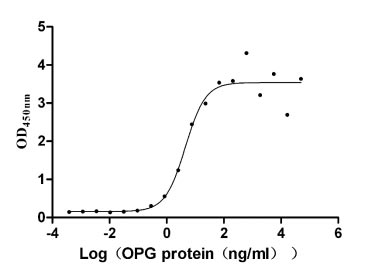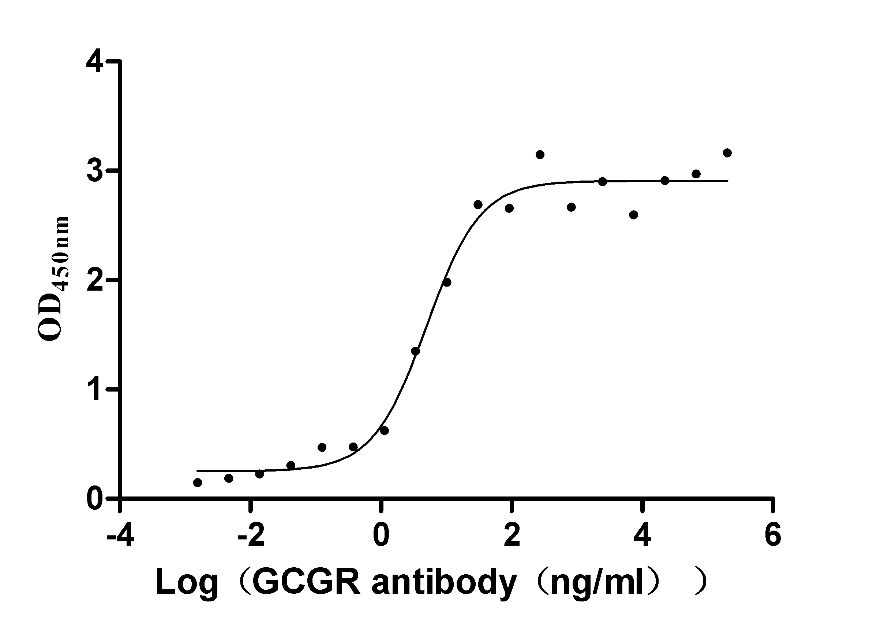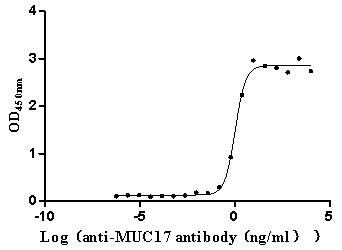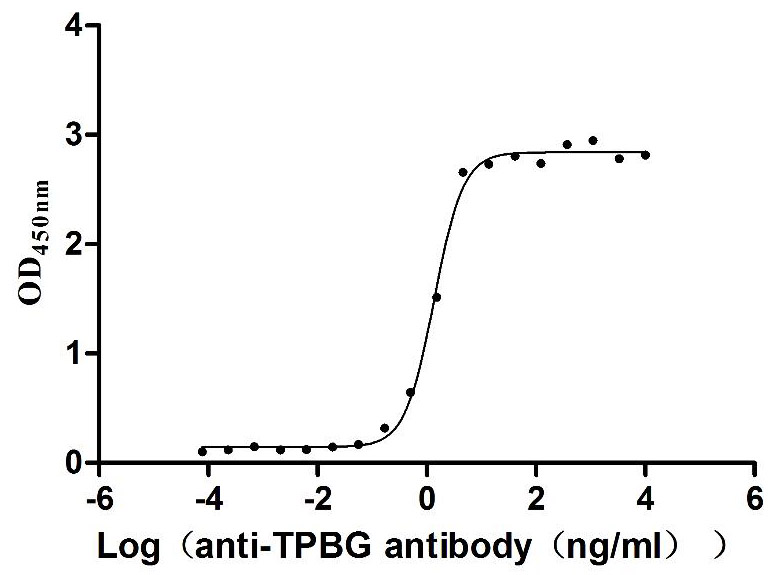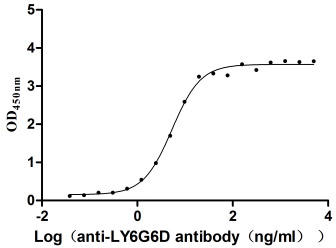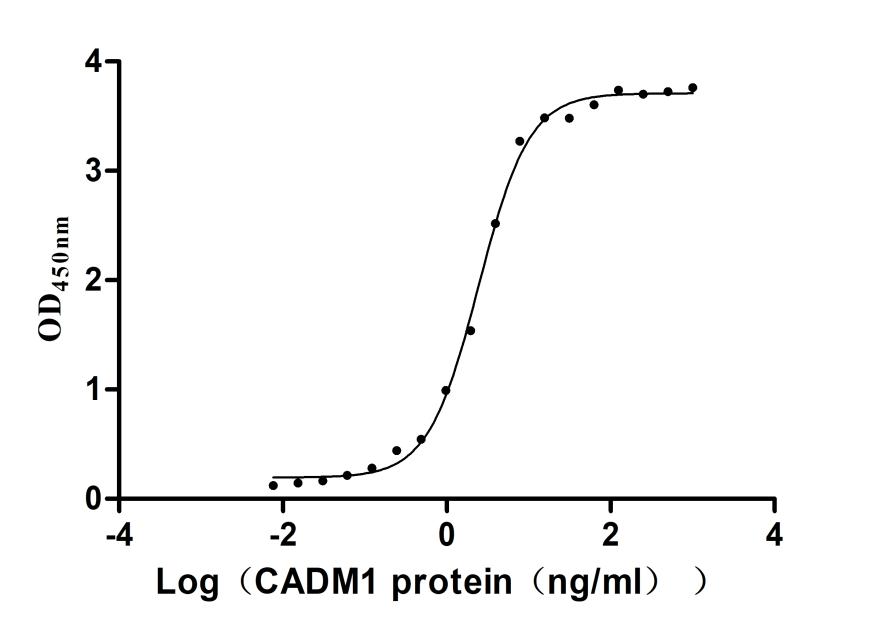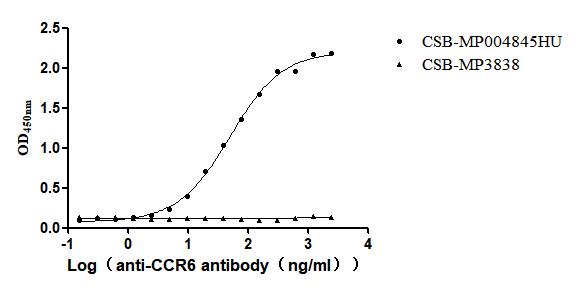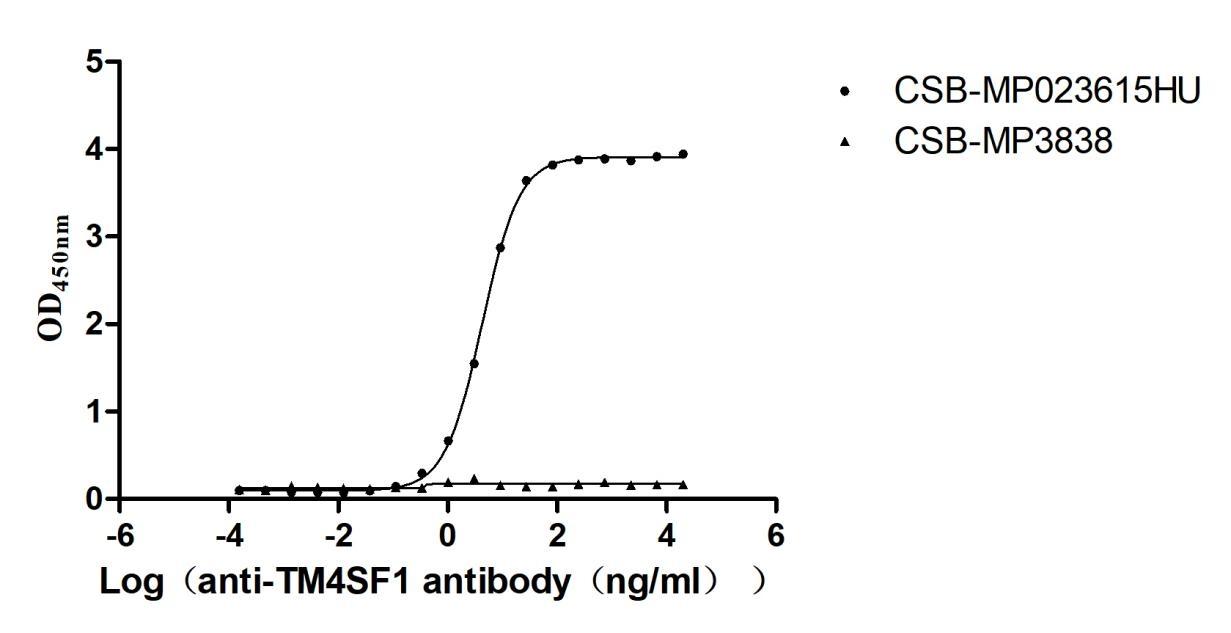Recombinant Chikungunya virus Non-structural polyprotein, partial
-
中文名稱:Recombinant Chikungunya virus Non-structural protein 4 (nsP4), partial
-
貨號:CSB-YP810351CJAT
-
規格:
-
來源:Yeast
-
其他:
-
中文名稱:Recombinant Chikungunya virus Non-structural protein 4 (nsP4), partial
-
貨號:CSB-EP810351CJAT-B
-
規格:
-
來源:E.coli
-
共軛:Avi-tag Biotinylated
E. coli biotin ligase (BirA) is highly specific in covalently attaching biotin to the 15 amino acid AviTag peptide. This recombinant protein was biotinylated in vivo by AviTag-BirA technology, which method is BriA catalyzes amide linkage between the biotin and the specific lysine of the AviTag.
-
其他:
-
中文名稱:Recombinant Chikungunya virus Non-structural protein 4 (nsP4), partial
-
貨號:CSB-BP810351CJAT
-
規格:
-
來源:Baculovirus
-
其他:
-
中文名稱:Recombinant Chikungunya virus Non-structural protein 4 (nsP4), partial
-
貨號:CSB-MP810351CJAT
-
規格:
-
來源:Mammalian cell
-
其他:
產品詳情
-
純度:>85% (SDS-PAGE)
-
基因名:N/A
-
Uniprot No.:
-
別名:Polyprotein P1234; P1234; Non-structural polyprotein) [Cleaved into: Polyprotein P123; P123); mRNA-capping enzyme nsP1; EC 2.1.1.-; EC 2.7.7.-; Non-structural protein 1); Protease nsP2; EC 3.1.3.33; EC 3.4.22.-; EC 3.6.1.15; EC 3.6.4.13; Non-structural protein 2; nsP2); Non-structural protein 3; nsP3; EC 3.1.3.84); RNA-directed RNA polymerase nsP4; EC 2.7.7.19; EC 2.7.7.48; Non-structural protein 4; nsP4)]
-
種屬:Chikungunya virus (strain S27-African prototype) (CHIKV)
-
蛋白長度:Partial
-
蛋白標簽:Tag?type?will?be?determined?during?the?manufacturing?process.
The tag type will be determined during production process. If you have specified tag type, please tell us and we will develop the specified tag preferentially. -
產品提供形式:Lyophilized powder
Note: We will preferentially ship the format that we have in stock, however, if you have any special requirement for the format, please remark your requirement when placing the order, we will prepare according to your demand. -
復溶:We recommend that this vial be briefly centrifuged prior to opening to bring the contents to the bottom. Please reconstitute protein in deionized sterile water to a concentration of 0.1-1.0 mg/mL.We recommend to add 5-50% of glycerol (final concentration) and aliquot for long-term storage at -20℃/-80℃. Our default final concentration of glycerol is 50%. Customers could use it as reference.
-
儲存條件:Store at -20°C/-80°C upon receipt, aliquoting is necessary for mutiple use. Avoid repeated freeze-thaw cycles.
-
保質期:The shelf life is related to many factors, storage state, buffer ingredients, storage temperature and the stability of the protein itself.
Generally, the shelf life of liquid form is 6 months at -20°C/-80°C. The shelf life of lyophilized form is 12 months at -20°C/-80°C. -
貨期:Delivery time may differ from different purchasing way or location, please kindly consult your local distributors for specific delivery time.Note: All of our proteins are default shipped with normal blue ice packs, if you request to ship with dry ice, please communicate with us in advance and extra fees will be charged.
-
注意事項:Repeated freezing and thawing is not recommended. Store working aliquots at 4°C for up to one week.
-
Datasheet :Please contact us to get it.
相關產品
靶點詳情
-
功能:Inactive precursor of the viral replicase, which is activated by cleavages carried out by the viral protease nsP2.; The early replication complex formed by the polyprotein P123 and nsP4 synthesizes minus-strand RNAs. As soon P123 is cleaved into mature proteins, the plus-strand RNAs synthesis begins.; Cytoplasmic capping enzyme that catalyzes two virus-specific reactions: methyltransferase and guanylyltransferase. mRNA-capping is necessary since all viral RNAs are synthesized in the cytoplasm, and host capping enzymes are restricted to the nucleus (Probable). The enzymatic reaction involves a covalent link between 7-methyl-GMP and nsP1, whereas eukaryotic capping enzymes form a covalent complex only with GMP. nsP1 capping consists in the following reactions: GTP is first methylated into 7-methyl-GMP and then is covalently linked to nsP1 to form the m7GMp-nsP1 complex from which 7-methyl-GMP complex is transferred to the mRNA to create the cap structure. NsP1 is also needed for the initiation of the minus-strand RNAs synthesis. At the initiation of virus replication, mediates the assembly of the viral replication complex made of the non-structural proteins, the association of this complex with the inner face of the plasma membrane and the formation of membranous spherules that serve as replication complex factories. Forms the neck of these spherules with a central channel for mediating communication and the passage of RNA, nucleotides, and small proteins between the viral replication complex and the host cytoplasm. Palmitoylated nsP1 is remodeling host cell cytoskeleton, and induces filopodium-like structure formation at the surface of the host cell.; Multifunctional protein whose N-terminus is part of the RNA polymerase complex and displays NTPase, RNA triphosphatase and helicase activities. NTPase and RNA triphosphatase are involved in viral RNA capping and helicase keeps a check on the dsRNA replication intermediates. The C-terminus harbors a protease that specifically cleaves the polyproteins and releases the mature proteins. Required for the shutoff of minus-strand RNAs synthesis. Specifically inhibits the host IFN response by promoting the nuclear export of host STAT1. Also inhibits host transcription by inducing the rapid proteasome-dependent degradation of POLR2A, a catalytic subunit of the RNAPII complex. The resulting inhibition of cellular protein synthesis serves to ensure maximal viral gene expression and to evade host immune response (Probable).; Seems to be essential for minus-strand RNAs and subgenomic 26S mRNAs synthesis. Displays mono-ADP-ribosylhydrolase activity. ADP-ribosylation is a post-translational modification that controls various processes of the host cell and the virus probably needs to revert it for optimal viral replication. Binds proteins of G3BP family and sequesters them into the viral RNA replication complexes thereby inhibiting the formation of host stress granules on viral mRNAs. The nsp3-G3BP complexes bind viral RNAs and probably orchestrate the assembly of viral replication complexes, thanks to the ability of G3BP family members to self-assemble and bind DNA (Probable).; RNA dependent RNA polymerase. Replicates genomic and antigenomic RNA by recognizing replications specific signals. The early replication complex formed by the polyprotein P123 and nsP4 synthesizes minus-strand RNAs. The late replication complex composed of fully processed nsP1-nsP4 is responsible for the production of genomic and subgenomic plus-strand RNAs.
-
基因功能參考文獻:
- Chikungunya virus (CHIKV) nonstructural protein nsP3 (Nsp3)C-terminal hypervariable domain (HVD) can bind cytoskeletal proteins, including CD2AP, SH3KBP1, CAPZA1, CAPZA2 and CAPZB. Binding site is mapped to the second SH3 ligand-like element in Nsp3 HVD. Mutation of the short binding element hampered the ability of the virus to establish infection. PMID: 29702546
- In summary, nsP3 can form uniquely stable granular structures that persist long-term within the host cell. PMID: 29875241
- Therefore, the opal termination codon at the end of the nsp3 gene plays an important role in Chikungunya virus pathogenesis, independently of effects on viral replication. PMID: 29138302
- Two non-structural proteins, namely, nsP2 and nsP3 were found to exhibit RNAi suppressor activity. PMID: 27901124
- Cys478 residue in the active site of CHIKV nsP2 is indispensable for P1234 processing. PMID: 27845418
- Date show that viral nonstructural protein nsP3 (nsP3) mono(ADP-ribosyl)hydrolase activity is critical for Chikungunya virus (CHIKV) replication in both vertebrate hosts and insect vectors, and for virulence in mice. PMID: 28143925
- data show that the previously described consensus sequence PXRPXR for amphiphysin SH3 ligands is inaccurate and instead define it as an extended Class II binding motif PXXPXRpXR, where additional positive charges between the two constant arginine residues can give rise to extraordinary high SH3 binding affinity. PMID: 27268056
- Site-directed mutagenesis showed that the mosquito Rin-Chikungunya virus nsP3 interaction involved the NTF2-like domain of Rin and two conserved TFGD repeats in the C-terminal variable domain of nsP3. PMID: 26384002
- This study shows the essential role and novel function of nsP2 in maintaining alphavirus replication complex fidelity. PMID: 26311883
- Molecular docking analysis/molecular dynamics simulations leading to enzyme inhibitors targeting nsP3 macro domain of chikungunya virus. PMID: 24756552
- P718G or E116K mustation of nsp2 markedly reduced RNA synthesis. PMID: 25552719
- Authors have identified novel interactions between Chikungunya virus nsP3 or nsP4 proteins with the host stress-pathway chaperone HSP-90 protein. PMID: 24388965
- Functional cross-talk between distant domains of chikungunya virus non-structural protein 2 is decisive for its RNA-modulating activity. PMID: 24407286
- Results show that nsP2 mutation P718S only in combination with KR649AA or adaptive mutation D711G allowed noncytopathic replicon RNA replication. PMID: 23864632
- Authors conclude that BST-2 tethers chikungunya virus like particles on the host cell plasma membrane and identify viral nsP1 protein as a novel BST-2 antagonist. PMID: 23411007
- Chikungunya virus nsP3 blocks stress granule assembly by recruitment of G3BP into cytoplasmic foci PMID: 22837213
- Viral nsP2 interacts with hostibonucleoprotein K and ubiquilin 4 protein. PMID: 22258240
- Expression of individual CHIKV nonstructural proteins (nsPs) showed that nsP2 was a potent inhibitor of IFN-induced JAK-STAT signaling. PMID: 20686047
顯示更多
收起更多
-
亞細胞定位:[Polyprotein P1234]: Host cytoplasmic vesicle membrane; Peripheral membrane protein.; [Polyprotein P123]: Host cytoplasmic vesicle membrane; Peripheral membrane protein.; [mRNA-capping enzyme nsP1]: Host cytoplasmic vesicle membrane; Lipid-anchor. Host cell membrane; Lipid-anchor; Cytoplasmic side. Host cell projection, host filopodium.; [Protease nsP2]: Host cytoplasmic vesicle membrane; Peripheral membrane protein. Host nucleus. Host cytoplasm.; [Non-structural protein 3]: Host cytoplasmic vesicle membrane; Peripheral membrane protein.; [RNA-directed RNA polymerase nsP4]: Host cytoplasmic vesicle membrane; Peripheral membrane protein.
-
數據庫鏈接:
KEGG: vg:956309
Most popular with customers
-
Recombinant Human Tumor necrosis factor receptor superfamily member 11B (TNFRSF11B) (Active)
Express system: Mammalian cell
Species: Homo sapiens (Human)
-
Recombinant Human Glucagon receptor (GCGR), partial (Active)
Express system: Mammalian cell
Species: Homo sapiens (Human)
-
Recombinant Human Mucin-17 (MUC17), partial (Active)
Express system: Mammalian cell
Species: Homo sapiens (Human)
-
Recombinant Human Trophoblast glycoprotein (TPBG), partial (Active)
Express system: Mammalian cell
Species: Homo sapiens (Human)
-
Recombinant Macaca fascicularis lymphocyte antigen 6 family member G6D (LY6G6D) (Active)
Express system: Yeast
Species: Macaca fascicularis (Crab-eating macaque) (Cynomolgus monkey)
-
Recombinant Human Cytotoxic and regulatory T-cell molecule (CRTAM), partial (Active)
Express system: Mammalian cell
Species: Homo sapiens (Human)
-
Recombinant Human C-C chemokine receptor type 6(CCR6)-VLPs (Active)
Express system: Mammalian cell
Species: Homo sapiens (Human)
-
Recombinant Human Transmembrane 4 L6 family member 1(TM4SF1)-VLPs (Active)
Express system: Mammalian cell
Species: Homo sapiens (Human)


